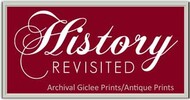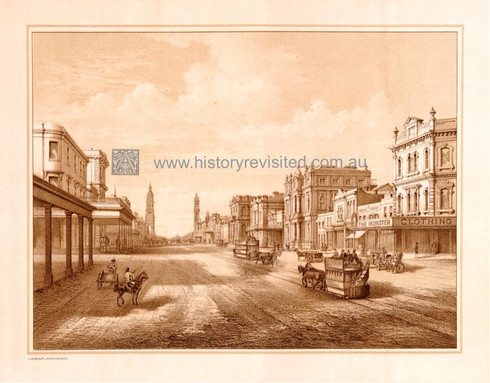 Loading... Please wait...
Loading... Please wait...All prices are in All prices are in NZD
Categories
- Home
- Giclee Prints
- Giclee, Henn, King William, Adelaide, South Australia, retail
- Home
- Giclee Prints
- South Australian Scenes
- Giclee, Henn, King William, Adelaide, South Australia, retail
- Home
- Giclee Prints
- South Australian Scenes
- Louis Henn & Co., SA, 1880s
- Giclee, Henn, King William, Adelaide, South Australia, retail
Product Description
Giclee Louis Henn & Co., King William St., Adelaide South Australia, Colonial Architecture, Trams, Retail
Archival limited edition Giclee Inkjet printed on cotton paper after the original lithograph by Louis Henn & Co, published in Currie St., Adelaide, 1882-84.
Size of Image = 32.5 cm X 24.5 cm (13x 9 2/3 inch)
Issued with numbered Limited Edition certificate including history.
Rundle Street in Louis Henn's Time
View from Rundle Street to the left and Hindley Street to the right. Looking south we see two Policemen under the near verandah, the Adelaide Town Hall, to the far left, was completed in 1866. However, the clock was not installed until 1935 as a centenary gift, by John Lavington Bonython, Lord Mayor and owner of "The Advertiser". the General Post Office to the far right. Opened in 1872, it played a significant role in receiving the first message along the Overland Telegraph Line in the same year.
In the left foreground we see Monster Clothing. This was opened by Joel Moss in 1866 & traded until 1903. It may have been named after the Burra "Monster Mine" discovered in 1845.(Find out about the "Snobs" & "Nobs") This enormous deposit of copper was a salvation for the small freely settled colony. Shares paid handsomely and many early migrants did well. This may have been Joel Moss' experience.
We see the Horse drawn carriages: Adelaide developed Australia’s first permanent (and largest) horse tram system that grew to 82 kilometers. By 1883 there were eleven companies operating horse drawn trams. Electrification was introduced in 1895 down King William Street for both trams and lighting.
The Major carriage-way of the city is named after King William IV, as the city is named after his wife, Queen Adelaide. This view takes us up to Victoria (Queen) Square. The Prototype Free settlement was promoted as “a slice of London in the Antipodes”. It is interesting to note that the names on either side of the grid that cross King William change their name. This is simply because, for a road to have the same name would be “to cross the Kings name” which would be unacceptable to social and Royal protocol.
Product Videos
-
 Keith Conlon's...Keith Conlon took a group of listeners on a History walk of Ki...
Keith Conlon's...Keith Conlon took a group of listeners on a History walk of Ki...














